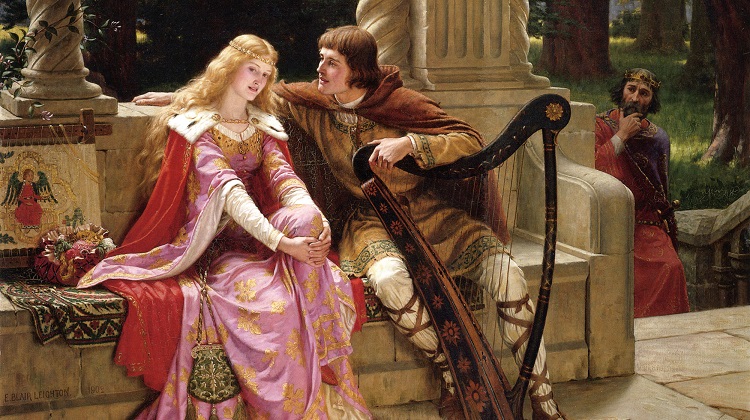EROS, AGAPE, AMOR
By Joseph Campbell

In theological sermons we are used to hearing of a great distinction between fleshly and spiritual love, eros and agape. The contrast and conflict were already recognized and argued by the early Christian Fathers and have been argued ever since. An important point to be recognized, however, is that the ideal of love, amor, of the lovers and poets of the Middle Ages corresponded to neither of these.
In the words, for example, of the troubadour Giraut de Borneil, “Love is born of the eyes and the heart” (Tam cum los oills el cor ama parvenza): the eyes recommend a specific image to the heart, and the heart, “the noble heart,” responds. That is to say, this love is specific, discriminative, personal, and elite. Eros, on the other hand, is indiscriminate, biological: the urge, one might say, of the organs. And agape, too, is indiscriminate: Love thy neighbor (whoever he may be) as thyself. Whereas, here, in the sentiment and experience of amor, we have something altogether new—European—individual. And I know of nothing like it, earlier, anywhere in the world.
The aim in the European “cult” (if we may call it that) of amor was not in any sense ego extinction in a realization of nonduality, but the opposite: ego-ennoblement and -enrichment through an altogether personal experience of love’s poignant pain—“love’s sweet bitterness and bitter sweetness,” to quote Gottfried—in willing affirmation of the irremediable yearning that animates all relationships in this passing world of ephemeral individuation.
It is true that in the doctrine of love represented by the Troubadours marriage was not only of no interest but actually contrary to the whole feeling, and that likewise in India, the highest type of love, from the point of view of the Sahajiya cult, was not of husband and wife, but (to quote one authority), “the love that exists most privately between couples, who are absolutely free in their love from any consideration of loss and gain, who defy society and transgress the law and make love the be-all of life.”
It is almost certainly not by mere coincidence that the greatest Indian poetic celebration of this ideal of adulterous (parakiya) love—namely the Gita Govinda (“Song of the Cowherd”) of the young poet Jayadeva—is of a date exactly contemporary with the flowering in Europe of the Tristan romance (c. A.D. 1175). A moment’s comparison of the two romances, however, immediately sets apart the two worlds of spiritual life. The Indian lover, Krsna, is a god; the European, Tristan, a man.
The Indian work is allegorical of the yearning of flesh (symbolized in Radha) for the spirit and of spirit (symbolized in Krsna) for the flesh, or, in Coomaraswamy’s terms, symbolic of “the ‘mystic union’ of the finite with its infinite ambient”; whereas the European poets, Thomas of Britain (c. 1185), Eilhart von Oberge (c. 1190), Béroul (c. 1200), and Gottfried von Strassburg (c. 1210), the four leading masters of the Tristan cycle, have represented the lovers as human, all too human—overwhelmed by a daemonic power greater than themselves.
In the poems of the first three, the power of the potion, the releaser of the passion, is treated simply as of magic. In Gottfried’s work, on the other hand, a religious dimension opens—heretical and dangerous—when he states, and states again, that the power is of the goddess Minne (Love). And then, moreover, to ensure his point, when the lovers flee to the forest, he brings them to a secret grotto of the goddess, described explicitly as an ancient heathen chapel of love’s purity, and with a bed—a wondrous crystalline bed— in the place of the Christian altar.
___________________________________________________________________________
Excerpt from: Campbell, Joseph., The Flight Of The Wild Gander – 1969